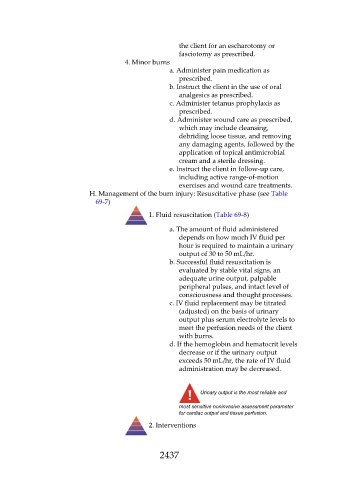Page 2437 - Saunders Comprehensive Review For NCLEX-RN
P. 2437
the client for an escharotomy or
fasciotomy as prescribed.
4. Minor burns
a. Administer pain medication as
prescribed.
b. Instruct the client in the use of oral
analgesics as prescribed.
c. Administer tetanus prophylaxis as
prescribed.
d. Administer wound care as prescribed,
which may include cleansing,
debriding loose tissue, and removing
any damaging agents, followed by the
application of topical antimicrobial
cream and a sterile dressing.
e. Instruct the client in follow-up care,
including active range-of-motion
exercises and wound care treatments.
H. Management of the burn injury: Resuscitative phase (see Table
69-7)
1. Fluid resuscitation (Table 69-8)
a. The amount of fluid administered
depends on how much IV fluid per
hour is required to maintain a urinary
output of 30 to 50 mL/hr.
b. Successful fluid resuscitation is
evaluated by stable vital signs, an
adequate urine output, palpable
peripheral pulses, and intact level of
consciousness and thought processes.
c. IV fluid replacement may be titrated
(adjusted) on the basis of urinary
output plus serum electrolyte levels to
meet the perfusion needs of the client
with burns.
d. If the hemoglobin and hematocrit levels
decrease or if the urinary output
exceeds 50 mL/hr, the rate of IV fluid
administration may be decreased.
Urinary output is the most reliable and
most sensitive noninvasive assessment parameter
for cardiac output and tissue perfusion.
2. Interventions
2437

